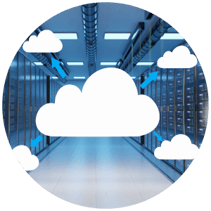The Benefits of Moving to the Cloud for Remote Work Productivity

Four-minute read
The tech industry notoriously loves to use nebulous and arbitrary buzzwords, like "big data," "net neutrality," or "machine learning." Rest assured, though, cloud computing isn't one of them.
In reality, the concept of the cloud has been floating around since the 1960s (even if it was just a wild concept at the time). Since then, however, it has not only been fully realized but has matured rapidly to level the playing field among businesses of all sizes.
What is "The Cloud"?
In the simplest terms, "the cloud" or "cloud computing" involves storing and accessing data over the internet instead of in some physical infrastructure, like your computer's hard drive. Within this definition, there are three distinct service models: Infrastructure as a Service (IaaS), Platform as a Service (PaaS), and Software as a Service (SaaS).
IaaS
This encompasses the fundamental building blocks of computing that can be rented, whether that's physical or virtual servers, storage or networking.
PaaS
This is the next layer up from IaaS. On top of the underlying storage, networking, and virtual servers, PaaS also includes the tools and software required to build applications, including middleware, database management, operating systems, and development tools.
SaaS
As expected, this is the delivery of applications as a service. SaaS is likely the version of cloud computing that most people are familiar with because the underlying hardware and operating system are generally irrelevant to the typical end-user, who will access the service via a web browser or app.
Yes, IaaS, PaaS, and SaaS are distinctly different service models, but they are not mutually exclusive. While many organizations understand and utilize more than one, the concept of the massive power-consuming data processing that is happening on the other end in a data center may be a bit ambiguous to an individual user. Moreover, cloud computing is such a large umbrella concept that you may not even know you're using it. However, if you're taking advantage of applications like Microsoft Teams, Google Drive, Apple iCloud, Dropbox, and a slew of others, you're already exploiting the cloud!

Cloud Deployment Models
There are plenty of cloud service providers in the market, but the most popular are Amazon Web Services (AWS), Microsoft Azure, and Google Cloud. As you research cloud providers to identify one that offers services that best fit your organization, you'll also have five main cloud deployment models to choose from: public, private, hybrid, community, and multi-cloud.
Public
This is the classic, most popular cloud-computing model. With a public cloud, you don't own any hardware; users access a large pool of computing power over the internet from a cloud service provider. With this model, you gain the ability to rapidly scale a service because of the vast amounts of computing power available from the "multi-tenant" architecture.
Private
This is essentially the opposite of the public cloud. With the private cloud, organizations can benefit from the flexibility of the public cloud but also gain an added layer of data security because all information is tucked away behind the corporate firewall. Therefore, companies can control precisely where their data is being held with customized infrastructure.
Hybrid
As expected, this model combines private and public cloud environments. Some less-sensitive data is stored in the public cloud, and the more sensitive projects are stored in the private cloud (which can also be on-premise servers). In the hybrid model, organizations utilize multiple vendors with different cloud usage levels to work as one system.
Community
This model represents a cloud dedicated to a few organizations within the same community. In this case, it's not a public cloud (because it's essentially "members only"), but it's also not a private cloud dedicated to a single company. Although it's not particularly popular, it's worth being aware of.
Multi-cloud
As the name suggests, this model uses more than one cloud provider at a time for redundancy, or increased reliability. Although all public cloud providers provide options for fail-safes, accidents still happen. With multiple cloud providers, you have an added layer of security and comfort knowing that if an accident occurs with one provider, your backup provider will still be available.
At a basic level, companies rent access to anything from applications to storage from a cloud service provider rather than owning onsite infrastructure or data centers. At this point, nearly any service that doesn't require you to be physically close to the computer hardware that you are using can now be delivered via the cloud.
Although there's a significant amount of cloud-related information, here's the takeaway: with an internet
connection, cloud computing allows you to work anywhere, anytime.
Benefits
Traditionally the most widely discussed benefit is avoiding the upfront cost of owning and maintaining on-premise IT infrastructure, decreased complexity, increased security, and faster deployment times. However, in this era, the focus is shifting to the benefits for remote-work productivity: connectivity and accessibility, increased collaboration, and improved efficiency.
Connectivity and accessibility
With cloud technology, users within your organization can access all your files from anywhere, using any device. All information is accessible 24/7 with an internet connection. With that freedom also comes decreased risk since files are no longer stored on any physical computer.
Increased collaboration
Switching to the cloud supports simultaneous syncing, working, and sharing files in real-time, thereby increasing the collaboration and efficiency of employees. Now the location of employees is insignificant; employees from all over the world can collaborate seamlessly.
Improved efficiency
Gone are the days when you worry about your organization's power requirements, space considerations, expensive computer hardware, or software updates. Similarly, the downtime associated with these issues is in the past. When you shift to the cloud, your entire company can stay focused on building quality relationships that generate revenue, not on IT issues.
The Future of Remote Work
Increased flexibility, enhanced integration capabilities, improved work processes, and reduced overhead costs will continue to drive organizations to utilize the cloud. Small and medium-sized businesses (SMBs) can now compete with larger corporations as new, powerful web-based business apps shift the financial costs and bridge the "software divide" that once separated them.
With this technology, SMBs can measure significant benefits from their cloud investments, including increased productivity throughout their organization. With unbounded connectivity and accessibility, increased collaboration, and improved efficiency, your organization can operate at its intended level.
Are you curious about how you can boost internal productivity? Our experts would be honored to answer any questions you may have – and don't forget to check out our free monthly training session focused on enabling your teams to do their best work.



